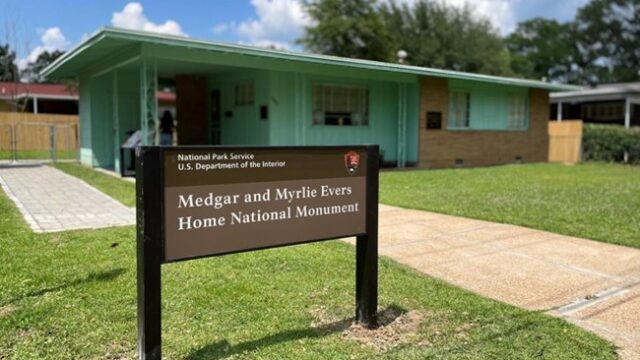Unearthing Hidden Gems: Exploring African American History in Our National Parks

Black History Month is a wonderful opportunity to unearth the often-overlooked chapters of African American history etched within our national park system. Within the familiar landmarks, there exists a tapestry of hidden gems, testaments to the resilience and triumphs of Black Americans. Join us as we dive into stories of courage, activism, and the pursuit of justice, shedding light on these important narratives.
Medgar and Myrlie Evers Home National Monument – Jackson, Mississippi
The Medgar and Myrlie Evers Home National Monument pays tribute to civil rights activists Medgar and Myrlie Evers, whose humble ranch home was a focal point for their dedicated efforts against racial injustice. Medgar, a WWII veteran, and Myrlie engaged in civil rights advocacy, opening the first NAACP Mississippi State Office. They faced threats and violence while organizing boycotts, voter registration drives, and investigating racial violence. Medgar’s assassination in 1963 spurred the passage of the Civil Rights Act of 1964. Myrlie, an accomplished activist figure, became one of the first African American women to run for Congress and later chaired the NAACP. Despite a 31-year wait for justice after Medgar’s murder, Myrlie remains an inspiring advocate for equality. The ranch was authorized as a national monument in 2019 and acquired by the National Park Service at the end of 2020.

Brown v. Board of Education National Historical Park – Topeka, Kansas
Originally designated in 1992, Brown v. Board of Education National Historic Site in Topeka, Kansas, underwent a redesignation and expansion in 2022, further amplifying its significance in the ongoing narrative of dismantling racial segregation in public education. Brown v. Board of Education National Historical Park stands as a living testament to the pivotal U.S. Supreme Court decision. This landmark case, decided on May 17, 1954, boldly declared the inherent inequality of separate educational facilities and, in doing so, challenged the violation of the 14th Amendment to the United States Constitution, ensuring “equal protection of the laws” to all citizens. The heart of this national historical park lies in Monroe Elementary School, one of the once-segregated schools for African American children in Topeka, along with its surrounding grounds.

Emmett Till and Mamie Till-Mobley National Monument – Chicago, Illinois and Tallahatchie County, Mississippi
One of the most recent additions to the National Park System was the establishment of Emmett Till and Mamie Till-Mobley National Monument in 2023. The new national monument serves as a compelling narrative and preserves the tragic events surrounding Emmett Till’s murder, its profound impact on the civil rights movement, and its enduring significance in American history. This monument, a tribute to Emmett Till, a 14-year-old African American boy abducted, tortured, and lynched in Mississippi in 1955, and his courageous mother, Mamie Till, a pivotal figure in the Civil Rights Movement, unfolds a broader tale of Black oppression, resilience, and bravery in America. Spanning across three sites, with a collective area of 5.7 acres, the monument encompasses the church where Mamie Till insisted on an open casket funeral, the location where Till’s body was discovered, and the courthouse where the trial unfolded. This multifaceted monument is a testament to these painful but crucial chapters in American history, inviting reflection on the ongoing struggle for justice and equality.
This Black History Month, let’s explore the richness of African American history within the National Park System. These sites not only highlight the struggles and achievements of the past but also serve as reminders of the ongoing journey toward a more inclusive and equitable future. By acknowledging and preserving these stories, we can better comprehend our nation’s history and pave the way for a more united and just society.







